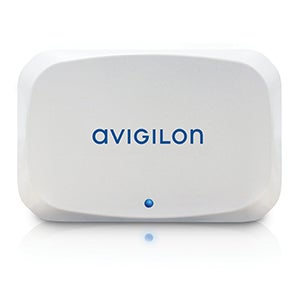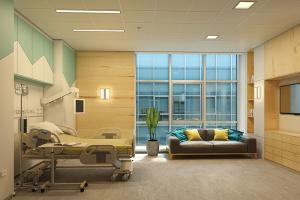Surveillance systems eye high-tech advances

Image courtesy of Verint Systems Inc.
Hospitals pose many challenges to providers of video surveillance systems, such as difficult lighting levels, complex building designs and privacy issues. Manufacturers are meeting these challenges by providing facility managers with total systems that combine the best of video surveillance, video analytics and sensors.
Today’s technologies are designed to help organizations increase awareness. Combined data is presented in a single user interface to deliver actionable intelligence. Bringing all data points into one platform allows for early detection of threats, and the data can be used to initiate better planning, response and decision making, experts say.
Total security solutions that combine access control with video surveillance, video analytics and sensors can help building managers monitor and control access to critical areas, including high-traffic and restricted zones, and respond to security threats. This is important for health care facilities that are faced with the challenge of providing a safe environment for staff and patients.
New surveillance systems also are designed to ensure patient privacy. “Video surveillance system providers need to ensure that video is protected and that only approved clinicians are able to access the data. In addition, in-room cameras need to be thermal or include LED privacy lights to alert patients and visitors to when the camera is being used,” says Paul Baratta, business development manager for health care, Axis Communications Inc., Chelmsford, Mass.
The right view
Choosing the best camera for a specific application — such as entrances, exits and possible points of congestion — can be a challenge. Security personnel need to tell the installing company the intended purpose of the camera in each area to ensure the appropriate selection, and that each camera is positioned correctly to capture the images needed, according to Chris Lennon, business development manager at Bosch Security and Safety Systems, Fairport, N.Y.
“In situations where video is mainly being used forensically and is not regularly being viewed live, fixed megapixel cameras are likely the best choice. In areas where active surveillance is common — such as outdoor areas, emergency rooms and other high-risk areas — pan-tilt-zoom cameras are the better choice, as operators need to be able to follow the movements of people or objects and zoom in over larger areas,” Lennon says.
To meet the challenge posed by difficult lighting environments inside hospitals, Avigilon Corp., a Motorola Solutions company, offers three types of technology: Wide Dynamic Range, which takes multiple exposure levels of light saturation and blends them to provide the best quality image; Adaptive IR for dark environments; and LightCatcher, which is designed to brighten images by using ambient light, according to Ryan LaFleur, director of health care business development, North America.
Small, off-site health care facilities pose another set of challenges. These facilities may face budget constraints that prevent them from reaching the level of security needed. “Bandwidth also can be an issue, as there are significant limitations as to what can be sent over the local area network/wide area network for video and even restrictions on data. This leads to limited monitoring, both by surveillance systems as well as by responsible individuals,” says Kyle Cusson, business development manager, security, at Schneider Electric, Andover, Mass.
Today’s video surveillance systems are connected to smartphones in a big way. “Apps enable access to live camera views and recordings via secured smartphones and tablets, giving security personnel, staff and clinicians the ability to monitor and respond to situations as they occur. This also allows for remote patient monitoring in areas where bedside cameras and audio devices have been installed for safety purposes,” Lennon says.
Remote monitoring has become a standard requirement of video surveillance systems, and mobile applications are growing in popularity because they enable users to experience a 360-degree video feed in high definition from a smartphone or tablet, according to Stuart Rawling, director of global business development at Pelco by Schneider Electric, Fresno, Calif. “The ability for building managers to remain mobile while accessing video feeds whenever they desire offers a new level of flexibility that is critical to the success of any security solution.”
‘Internet of things’
Video analytics is a growing part of today’s video surveillance systems, making video more proactive when it comes to real-time events. Through analytic technologies, facility managers can quickly identify and respond to events when they happen and find a specific incident. “In fact, video analytics can be used in the move toward the ‘internet of things’ — where cameras act as sensors to help gather actionable data and uncover trends for improving hospital safety,” Baratta says.
“Facial recognition software used with the surveillance system can prevent persons of interest or repeat offenders from entering a health care facility. Video analytics also can be used to count people in order to analyze traffic flow, or to adjust and regulate temperature and lighting within a specific room,” Cusson says.
Video analytic applications can propel increased situational awareness and provide instant notifications to facilitate immediate action, according to Alan Stoddard, vice president of situational intelligence solutions at Verint, Huntington, N.Y. “Advanced analytics, such as face recognition, help streamline investigations and help operators to make quick, informed decisions. I think we’ll see more health care organizations focus on automating intelligence gathering; video analytics will play a significant role in this trend.”
Video surveillance systems becoming part of the internet of things allows previously isolated security systems to be integrated with other security and building systems to provide health care facilities with an intelligent network of actionable information.
“Video surveillance is a foundational security element, but when connected with mass notification, access control and remote management, it creates a new value for health care managers,” says Julie Brown, institutional market leader at Johnson Controls Building Solutions North America, Milwaukee.
“These days, almost everything is connected to the network, and health care environments are no exception,” Rawling says. “With the right policy and network planning, facility managers can merge other internet of things devices with video surveillance to provide security administrators with more holistic data concerning ongoing activities within a facility.”
Other innovations
Video surveillance systems recently introduced to the health care market incorporate many of these features. For example, the Bosch Flexidome IP starlight 8000i series of cameras provide highly detailed images even in low-light situations. The technology captures color images in scenes with minimum ambient light, while high dynamic range ensures that details are captured in scenes with both dark and bright spots. “Built-in intelligent video analytics delivers a high level of accuracy. For example, setting an analytics rule for a virtual bed rail can help the hospital manage potential fall-risk patients,” Lennon says.
The Axis P1290-E Thermal Network Camera from Axis Communications can be used as a sensor to avoid compromising patient privacy. Thermal imaging detects incidents without revealing personal details of the people in the image. Together with analytics, the camera can trigger alerts or alarms in response to patient falls, allowing staff to take immediate action.
Pelco’s Evolution 180 camera features a high-definition panoramic view for comprehensive video surveillance and monitoring. It provides hospitals with an eye-level view of faces, enabling accurate identification. The outdoor model of the Evolution 180 enables eye-level views of building entrances and exits.
Schneider Electric’s EcoStruxure Access Expert, which works with Pelco’s video systems, features updated mass notification capabilities. Relevant parties receive notifications via email and text messaging, and the system is integrated into paging systems. “Access Expert is a cloud-based, access control platform that can operate as an on-premise solution within the end user’s private network, or in a hosted environment, using the same user interface for either application. In a hosted environment, it runs without servers or appliances on-site, lowering total cost of ownership and eliminating refreshes of servers and hardware,” Cusson says.
Verint has released new versions of its video and incident management solutions: a situational awareness platform and enterprise video management software (VMS). Upgrades include increases in capacity, scalability and responsiveness with the introduction of graphics chip decoding, new networking options and an improved situational awareness subsystem. “We’ve also improved efficiency via tighter integration of the situational awareness platform with other Verint solutions including Enterprise VMS, Dispatch Manager and FaceDetect,” Stoddard says.
More health care facilities are looking to artificial intelligence (AI) to help meet their security needs. In response, Avigilon offers Avigilon Appearance Search technology, which provides health care personnel with enhanced search capabilities. Using deep learning AI, the technology can sort through hours of footage to quickly locate a specific patient or vehicle of interest across an entire site. It can help locate a missing or eloped patient by analyzing and grouping video data to track a person’s route, identify their previous locations and render them safe.
Johnson Controls offers the False Alarm Reduction Service, an AI and machine learning-enabled cloud application that reduces false alarm activity and associated costs. Organizations can leverage the service when connected with other security solutions such as video surveillance. “With more than 98 percent of critical alarms identified as false, this service works with other systems to help solve a costly problem by reducing false alarm activity by up to 72 percent,” Brown says.
Parking security is a major issue for health care facilities. License plate recognition (LPR) analytics sometimes is used to ensure security. Video analytics allows for license plate recognition within video footage to identify potential persons of interest as well as those who have failed to pay their parking fees. It also enables license plate recognition in order to integrate information into access control systems, providing designated parking garage access tied to parking payment systems.
Lilin Americas Inc., Arcadia, Calif., has introduced standalone LPR cameras that recognize the numbers on license plates. The cameras have a built-in allowed list, denial list and visitor list. Remote actions and automation with live video can be performed for opening the gate, and sending HTTP post signals or alarms. In the event a denial is issued, the camera sends a notification to the smartphone of an authorized user.
“In the current era of the internet of things, IP video isn’t just about surveillance; it’s about extracting value and intelligence from the video that is captured. For example, a hospital’s parking spaces can be managed using analytics to determine peak hours of operation, handicap parking use, areas of congestion, average parking duration or unmoved vehicles,” says Joe Cook, president/general manager for Lilin Americas Inc.
With increased use of AI and deep learning, many experts predict that video analytics will be inherent in all health care security applications.
“Cybersecurity also will become more important as we move toward a more connected approach to security — particularly as our collected data becomes more sophisticated and critical,” LaFleur says.
Neal Lorenzi is a freelance writer based in Mundelein, Ill.

POINT OF VIEW
The situational awareness platform helps organizations combine data from multiple devices into a single pane-of-glass view. Verint Systems Inc.

ALL ANGLES
The Evolution 180 camera offers health care facilities an eye-level view for accurate detection and filters out ceiling and floor coverage to save on storage and bandwidth. Pelco by Schneider Electric

SECURE ENVIRONMENT
The P1290-E thermal network camera can be used as a sensor to avoid compromising patient privacy. Axis Communications

DRIVE THROUGH
This license-plate camera has a built-in allowed list, denial list and visitor list. Lilin Americas Inc.

SAFETY FIRST
The Flexidome IP starlight 8000i camera features built-in video analytics, which can be used to monitor fall-risk patients. Bosch Security Systems Inc.

SHARP EYE
Using radar analytics technology, this device helps to solve the challenge of accurate human presence detection in indoor areas where traditional devices may be limited. Avigilon, a Motorola Solutions Co.

ON ALERT
EcoStruxure Access Expert, which works with Pelco’s video security systems, features updated mass notification capabilities. Schneider Electric




